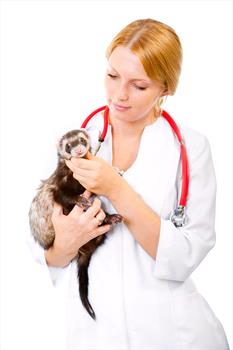Vet holding ferret

See your veterinarian if your ferret starts showing hair loss, aggression, or any of the other signs mentioned in this article.
Adrenal gland disease (AGD) in ferrets is one of the more common conditions that affects ferrets in North America. The signs are due to an abnormal production of sex steroids and androgens, but we do not know why the adrenal glands form tissue that causes this production. These steroids can lead to numerous disease conditions throughout the body. The average age at which AGD occurs in ferrets is three to four years of age. Adrenal gland disease may be more common in ferrets that have been spayed or neutered, but since most pet ferrets are desexed, it is difficult to know if this statement is true.
Adrenal Glands
Like most mammals, ferrets have two adrenal glands. Each gland is situated near the front edge of the corresponding kidney. Adrenal glands are small organs that secrete specific hormones to help the body maintain certain functions.
Signs
Signs of AGD in ferrets can include hair loss (referred to as alopecia) that typically starts on the tail and can include the entire rest of the body. About 30% of the ferrets with AGD are itchy. Most females have an enlarged vulva, and some male ferrets have difficulty urinating due to an enlarged prostate gland. About 30% of ferrets with AGD will manifest signs of sexual behavior, such as aggressiveness towards other ferrets or animals. These signs are all due to the increased concentration of sex steroids in the bloodstream.
Cause
AGD is characterized by the visible enlargement of one or both adrenal glands. The cause of the enlargement can be benign or malignant, but even if the cause is malignant, the cancerous adrenal gland cells rarely spread to other areas of the body. The underlying cause for the transformation of a normal adrenal gland into a diseased one is unknown. Theories on why this occurs include genetics (e.g. inbreeding); spaying or neutering at an early age; or prolonged exposure to daylight (i.e. increased photoperiod). The studies necessary to determine the ultimate cause of AGD have not yet been done.
Diagnosis
A physical examination by your veterinarian, coupled with typical signs, is often enough to diagnose AGD. Hormonal blood testing can be used to confirm it, but the disease is usually so obvious that it is typically unnecessary to run these tests for a firm diagnosis. Other lab work, such as a complete blood count (CBC) and plasma biochemistry, will help assess the general health of the ferret. Diagnostic imaging, such as radiographs and/or abdominal ultrasound, can be used to confirm the diagnosis, check for other disease conditions, and determine if one or both adrenal glands are diseased.
Treatment
Both surgical and medical management are treatment options for AGD. Although it is possible to cure AGD with surgery, there are risks. Adrenalectomy is a procedure that removes the diseased adrenal gland or glands. In some cases, only part of a diseased adrenal gland is removed, such as when surgery is too difficult or risky for full removal. If signs continue after this type of surgery, medical therapy may also be needed. Most ferrets do well with surgery, but the risks increase if the ferret has other diseases.
Medical therapy is another option. However, it does not cure AGD and must be continued for the rest of the ferret’s life. Medical therapy does not prevent the diseased glands from growing but rather slows the process, so signs may come back over time. If medical implants are used, they may have to be replaced annually or when symptoms return, because as the implant ages, the strength of the medication decreases. In the best case, medical therapy can limit or reverse the changes due to AGD.
Medications that can be effective for AGD in ferrets are available. Your veterinarian may prescribe:
- Deslorelin acetate
- Leuprolide acetate
- Melatonin
Some owners opt for no treatment. Sometimes, the ferret may have an acceptable quality of life with AGD if the only sign is hair loss. Once the ferret exhibits signs of AGD that negatively affect the quality of life, most people agree that some action must be taken. Euthanasia should be considered when a good quality of life is no longer possible. This can occur when medication is no longer effective, when surgery is not an option, and when an owner feels the quality of life has suffered too much.
Talk with your veterinarian about the best treatment options for your pet’s situation.
Prevention
Some researchers recommend not spaying or neutering ferrets, but there is not enough evidence to prove that this decreases the risk of a ferret developing AGD. Many owners object to the strong musky odor of intact male and female ferrets. Plus, intact female ferrets must be bred or medically taken out of heat, or they will develop fatal anemia associated with prolonged heat.
Adrenal Gland Disease in Other Animals
Adrenal gland disease that results in the overproduction of hormones in other animals is often called hyperadrenocorticism or Cushing’s disease. While the disease seems similar to AGD in ferrets, the signs, causes, and treatments differ significantly.